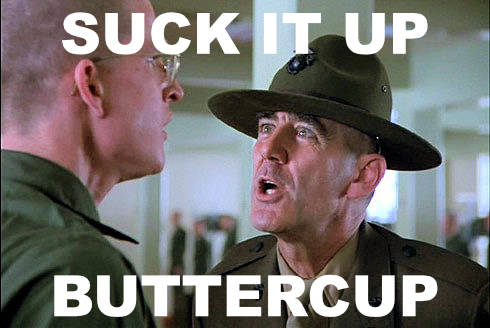Beginners vs Elites
A recent podcast I did with a friend of mine discussed the differences between performance coaching (getting people better quicker) and participation coaching (getting people hooked on the game and enjoying it). If you are a coach, I strongly recommend following his podcast and website. CLICK HERE to listen to that interview.
I stated that I would train elite golfers in a different way to beginner golfers. For example, some of the things which can speed up learning include;
- Random practice
- Pressure
- Increases in task difficulty during training
However, these things aren’t fun. For that reason, I usually don’t include these elements in programs designed for beginners because the goals are different (fun vs performance increases).
Ego-Massaging
 How do you currently train for golf?
How do you currently train for golf?
If you are like every golfer I see on the range (and I see a lot), you probably place an alignment stick down and proceed to scrape-and-hit a bucket of balls from the same spot to the same target with the same club, with no consequence if you mis-hit a shot.
By doing this, we are essentially making practice a hell of a lot easier than actual play. Research shows that by training in this way, we might see an increase in performance during training, but the retention and motor learning occurring is much lower.
So why do we do this?
Well, by making training easier, we wrap our ego in a nice, soft, warm cozy blanket where we feel safe and happy in the fact that we are hitting golf shots better than we can on the course.
Harsh Environments
It’s a fact of nature that when organisms are placed in a harsh environment, only the strongest and most fit for that environment survive – or organisms have to adapt to better suit the environment.
So how do you force your game to evolve? Put it in a harsh environment.
We have to stop mollycoddling ourselves and massaging our egos with overly-easy practice – let’s ramp up the intensity and practice like a Spartan.
Range Practice
It’s tough to make our range practice tougher than actual play, but there are definitely ways we can step-up the gear.
Random
By using random practice (changing clubs, targets, lies each time), we not only simulate the game itself better, but we increase the difficulty level from blocked practice modes.
Partner
Why not train with a buddy. The element of competition and the “observer effect” will make it much more like real golf. Play for some money to increase the pressure – or set a challenge such as “I must hit the ball between X and Y 10 times in a row or I am not leaving tonight”.
Go “old school”
Why not get on Ebay and find yourself an old 1 iron blade or a persimmon driver with a head the size of your hybrids.
These clubs are so difficult to use that your skill levels are forced to evolve. If you can learn to hit a blade 1-iron, going back to your modern forgiving clubs will feel like a piece of cake.
Don’t lie to yourself
Hitting on a pristine lie on the turf (or even driving range mat) can make it easier than what you find on the course. Why not learn to hit from some more demanding situations?
Get on a bare, hard-pan lie. This requires greater control of your ground strike. Or take it to the next level and hit out of a practice fairway bunker (if you are lucky enough to have one ay your facility). You can get away with hitting 4 inches behind it on a driving range mat, but you wont be able to get away with anything less than a pure strike from the bunker.
All of the above will make your practice more difficult than you normally conduct it. As a result, you will likely see a drop in performance.
However, you will be rewarded for your strength of character with improvements in skill, retention of learning and transfer to the golf course.
Brutal Golf
Why not take this idea out to the course?
“Brutalize” your own golf course using the following rules
 Play from the back tees
Play from the back tees- You are not allowed to use anything with more loft than your pitching wedge
- Play the rough and bunkers as a one-shot penalty
- Water hazards are deemed out of bounds – normal “stroke and distance” rule applies
- When your ball is on the green for the first time, you must drop it 15 paces directly away from the hole
- You must “pull back” your second putt exactly one putter-length away from the hole
Good luck.
Strike It Like A Pro.
Get ready to take your game to the next level, with the most comprehensive guide to striking the golf ball better.

